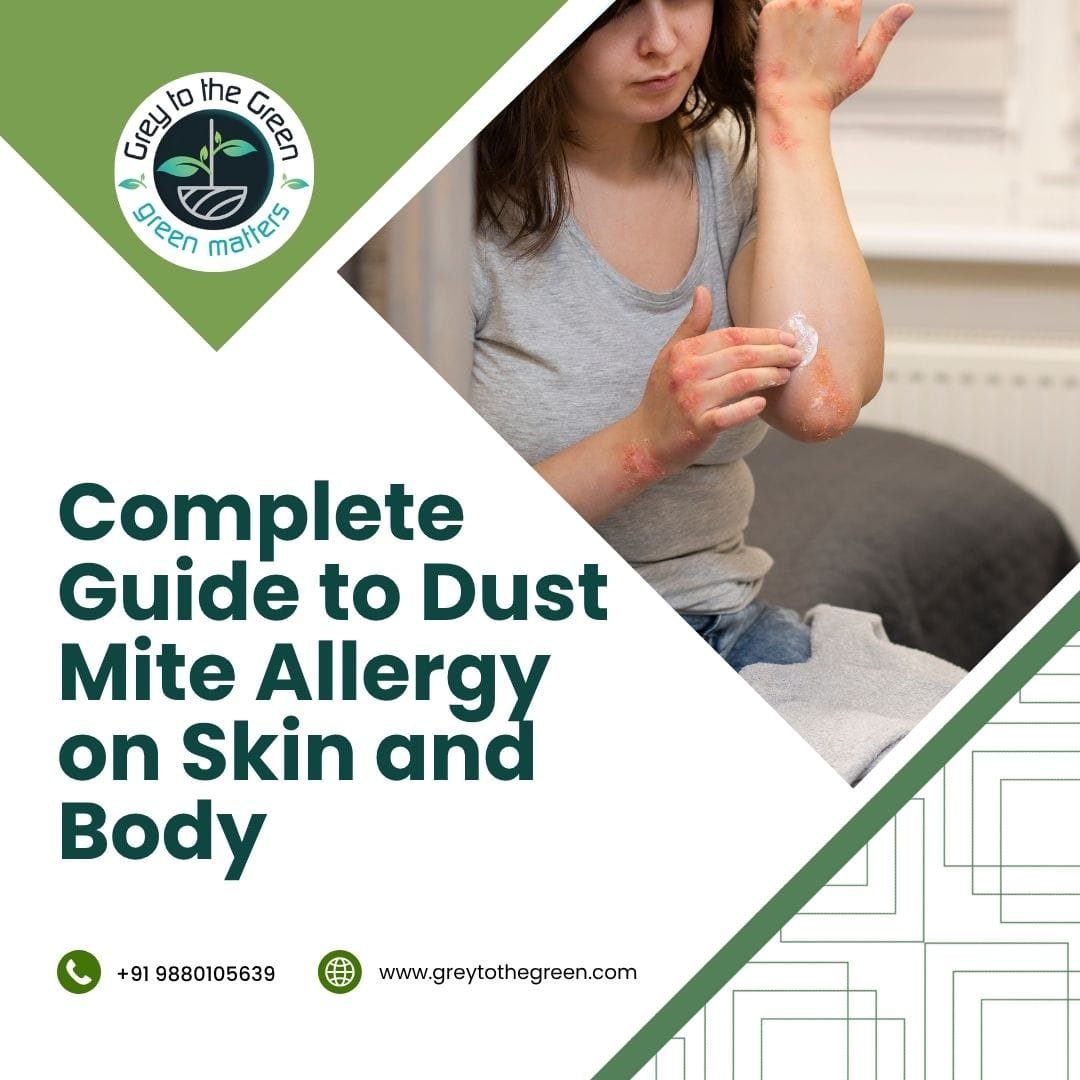Whether you’re already struggling with allergies and itchy skin or simply want to create a healthier living space, this guide has you covered.
Understanding the Scope: Startling Statistics
Dust mite allergies are far more common than we realize—and they impact skin health directly.
- Up to two-thirds of children with asthma and nearly half of adults who have asthma also suffer from allergies.
- Of these allergy sufferers, about 40% to 85% are allergic to house dust mites (HDM).
- This trend spans continents, including North America, Europe, Southeast Asia, and Australia.
- Around 5% to 30% of the general population shows sensitivity to dust mites in skin prick tests.
- An overwhelming 97% of people with dust mite allergies exhibit sensitization through skin exposure.
What Is Dust Mite Allergy on Skin?
Skin-Related Symptoms of Dust Mite Allergy
Common symptoms include:
- Redness and skin inflammation: A direct result of the skin reacting to mite allergens, causing swollen, warm, and irritated patches.
- Dry, flaky skin patches: This often appears on the face, arms, and legs where allergens accumulate.
- Persistent allergy itchy skin: The most telling symptom, where continuous exposure leads to intense itching and scratching.
- Raised welts or hives: Especially in sensitive individuals, the skin may react strongly to allergens by forming welts.
- Worsening of pre-existing skin conditions like eczema or dermatitis: Dust mites are known to trigger flare-ups in chronic skin disorders.
- Nighttime itching: Contact with mite-infested sheets, pillows, and mattresses can lead to aggravated symptoms during sleep, disturbing rest and worsening the condition.
The Role of Checkmite Anti-Dust Mite Spray
- Breaks down the allergenic proteins in dust mite droppings
- Helps prevent the recurrence of dust allergy skin rashs
- Reduces allergen load in your living spaces
- Creates a safer, more breathable environment for those allergic to dustmites
Signs You Might Have Dust Mite Skin Allergy
- Itchy, inflamed patches of skin
- Dry, scaly areas, particularly on arms and legs
- Recurrent hives or welts that come and go
- Worsening eczema or dermatitis
- Discomfort that eases when away from home
Misconceptions About Dust Allergies and Skin
Lifestyle Tips to Manage and Prevent Reactions
Preventing dust mite allergy on skin means creating a home environment that’s less friendly to mites. Here’s what you can do:
- 1. Wash bedding in hot water (at least 60°C) weekly. Dust mites die at high temperatures. Make this a routine.
- 2. Use allergen-proof mattress and pillow covers. These prevent mites from burrowing into your bed.
- Avoid wall-to-wall carpets if possible. They trap dust, making it difficult to remove allergens fully.
- Ventilate your space daily. Good airflow prevents moisture buildup, keeping humidity under control.
- Spray Checkmite regularly on beds, couches, curtains, and even car seats. It actively reduces exposure to allergenic proteins that lead to allergies dry skin and itching.
These practices make it easy for mites to multiply. That’s why consistent dust mite protection strategies are essential for anyone suffering from summer allergies.
Must-Spot Areas to Use Checkmite Anti-Dust Mite Spray at Home
To effectively protect yourself from dust mite allergy on skin, it’s important to target the right spots where dust mites thrive. Checkmite Anti-Dust Mite Spray is most effective when used on areas that come into regular contact with your skin and collect dust easily.
Mattresses and Pillows:
These are dust mite hotspots. Spray Checkmite on the surface of your mattress, pillow, and even the sides. Let it sit for a few minutes before making the bed.
Bedsheets and Blankets:
Spray lightly on bedsheets and duvet covers before use. This ensures allergens are neutralized before they come in contact with your body.
Sofas and Upholstered Furniture:
Living room sofas and fabric chairs are often overlooked. Spray the cushions and armrests weekly to keep them allergen-free.
Curtains and Drapes:
These gather dust daily. A light spray every few days can significantly reduce allergen buildup.
Carpets and Rugs:
Vacuum first, then spray Checkmite to break down remaining allergenic proteins in fibers.
Car Seats and Headrests:
If you spend time commuting, don’t forget your vehicle. Dust mites thrive in fabric-covered car interiors too.
Consistent use of Checkmite in these spots can drastically reduce skin allergies and improve overall indoor air quality.
Medical Treatment Options
If lifestyle changes aren’t enough, you may need to look into medical options:
- Antihistamines help relieve itching and reduce the allergic response.
- Topical corticosteroids may be prescribed for persistent rashes.
- Moisturizers tailored for sensitive or dry skin can help repair your skin barrier
- In more chronic cases, immunotherapy (allergy shots or tablets) might be recommended.
However, no treatment works if you’re still exposed to allergens daily. That’s why using Checkmite and maintaining cleanliness are foundational for people suffering from dust allergies on skin.
Children and Dust Mite Skin Allergies
Children are especially vulnerable to dust mite allergy on skin, as they spend more time on beds, floors, and soft toys—all prime mite zones. If your child has frequent rashes or allergy itchy skin, particularly on their back or face, it’s worth exploring environmental triggers.
Washing toys regularly, sun-drying pillows, and using Checkmite spray on their mattress can significantly reduce symptoms and help them sleep better.
Can Dust Mite Allergies Be Cured?
There’s no permanent cure for dust mite allergy on skin, but it can be managed effectively. You can significantly reduce symptoms and live comfortably by combining allergen control (like Checkmite), medical support, and good hygiene habits.
For many, symptoms reduce drastically once exposure is limited. You might not even realize how badly your skin was reacting until you remove the trigger.
Final Thoughts
Dust mite allergy on skin is one of the most overlooked causes of ongoing skin discomfort, irritation, and inflammation. From allergic reaction to dust on skin to common skin allergic reactions like hives or eczema, the symptoms can mimic other conditions, making diagnosis tricky.
But knowledge is power.
Now that you understand the causes, symptoms, and solutions, you can take real steps to protect yourself and your family. From cleaning habits to proven products like Checkmite Anti-Dust Mite Spray, relief is not just possible—it’s practical.
Don’t ignore persistent skin allergy symptoms. Listen to your skin, clean your space, and kick dust mites out—for good.
Frequently Asked Questions (FAQs)
What is dust mite allergy on skin?
Dust mite allergy on skin is a reaction caused by proteins in dust mite waste, leading to itching, rashes, or inflammation.
How do I know if I’m allergic to dust mites?
Common signs include morning itching, red patches, dry skin, and respiratory symptoms like sneezing or nasal congestion.
3. Can dust mites cause skin rashes?
Yes, dust mites can trigger skin rashes, especially in sensitive individuals or those with existing skin conditions like eczema.
4. How does Checkmite Spray help with dust mite allergies?
Checkmite neutralizes dust mite allergens on surfaces like mattresses, sofas, and curtains, preventing skin irritation and allergic reactions.
5. Where should I use Checkmite Spray in my home?
Use it on mattresses, pillows, sofas, carpets, curtains, and car seats—anywhere dust mites may live and cause allergic reactions.
6. Are children and babies affected by dust mite allergies?
Yes, children are more vulnerable due to frequent contact with soft surfaces. Regular use of Checkmite helps reduce exposure.
7. Can I completely eliminate dust mites from my home?
While you can’t remove all dust mites, using Checkmite Spray and maintaining cleanliness significantly reduces allergen levels.



